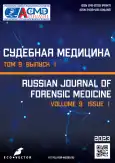Diabetic coma in the mortality of patients with diabetes mellitus
- Authors: Akimov P.A.1,2, Barinov E.K.3, Terekhina N.A.1
-
Affiliations:
- E.A. Vagner Perm State Medical University
- Perm Regional Bureau of Forensic Medical Examination
- Moscow State University of Medicine and Dentistry named after A.I. Evdokimov
- Issue: Vol 9, No 1 (2023)
- Pages: 41-48
- Section: Original study articles
- URL: https://journals.rcsi.science/2411-8729/article/view/133083
- DOI: https://doi.org/10.17816/fm410
- ID: 133083
Cite item
Full Text
Abstract
BACKGROUND: Statistics on the causes of death of patients with diabetes mellitus do not correspond to real indicators because of the insufficient level of diagnosis at the post-mortem stage of research in most regions of the country.
AIM: This study aimed to statistically analyze the mortality of patients with diabetes as a result of diabetic coma in the period from 2017 to 2020.
MATERIALS AND METHODS: The study examined blood and vitreous body of the eyes from 4444 patients with diabetes mellitus. The levels of glycohemoglobin in the blood and glucose, lactate, and acetoacetate in the vitreous body of the eyes were determined. The diagnosis of diabetic coma was made taking into account previously developed criteria.
RESULTS: A total of 692 (15.6%) patients with diabetes mellitus died of diabetic coma. Diabetic coma-related deaths occupy a much larger percentage of cases than is available in statistical data because of the insufficient implementation of laboratory tests at the post-mortem stage of diagnosis and restricted coding of the cause of diabetic coma-related death of patients with diabetes mellitus. Methods for diagnosing diabetic comas are easy to perform, guarantee high accuracy and reliability of results, and are available for any specialized laboratory.
CONCLUSION: The most common precomatous state (the beginning of the development of hyperosmolar non-ketoacidotic coma), which in combination with coma itself, leads to the highest rates of diabetic coma-related death. In recent years, diabetic coma-related death tended to reduce.
Keywords
Full Text
##article.viewOnOriginalSite##About the authors
Pavel A. Akimov
E.A. Vagner Perm State Medical University; Perm Regional Bureau of Forensic Medical Examination
Email: p.a.akimov@yandex.ru
ORCID iD: 0000-0003-4347-8760
SPIN-code: 9597-4566
Scopus Author ID: 56426895500
MD, Cand. Sci. (Med.), Associate Professor
Russian Federation, Perm; PermEvgeny K. Barinov
Moscow State University of Medicine and Dentistry named after A.I. Evdokimov
Email: ev.barinov@mail.ru
ORCID iD: 0000-0003-4236-4219
SPIN-code: 2112-4568
MD, Dr. Sci. (Med.), Professor
Russian Federation, MoscowNatalya A. Terekhina
E.A. Vagner Perm State Medical University
Author for correspondence.
Email: terekhina@list.ru
ORCID iD: 0000-0002-0168-3785
SPIN-code: 7663-4110
Scopus Author ID: 7004162006
MD, Dr. Sci. (Med.), Professor
Russian Federation, PermReferences
- Dedov II, ShestakovaMV, Vikulova OK, et al. Diabetes mellitus in Russian Federation: prevalence, morbidity, mortality, parameters of glycaemic control and structure of hypoglycaemic therapy according to the Federal Diabetes Register, status 2017. Diabetes Mellitus. 2018;21(3):144–159. (In Russ). doi: 10.14341/DM9686
- Dezhinova TA, Popov VL, Zaslavskii GI. Forensic biochemical research. Saint Petersburg; 2003. 96 р. (In Russ).
- Avhodiev GI, Kuzmina OV, Rafibekov MG. Proteins and their derivatives in the post-mortem period. Chita: Poisk; 2002. 79 р. (In Russ).
- Terekhina NA, Akimov PA. Biochemical analysis of the vitreous body of the eye in post-mortem diagnosis of diabetic coma. Pathological Physiology Experimental Therapy. 2005;(2):24–25. (In Russ).
- Patent RUS № 2131700 С1/20.06.1999. Akimov PA, Terekhina NA. Method of diagnosis of hyperglycemic coma in the postmortem periode. (In Russ). Available from: https://yandex.ru/patents/doc/RU2131700C1_19990620. Accessed: 12.05.2022.
- Akimov PA, Terekhina NA. Biochemical indices of vitreous humor in diagnosis of diseases. Perm Med J. 2016;33(4):61–64. (In Russ).
- Hess C, Musshoff F, Madea B. Disorders of glucose metabolism -- post mortem analyses in forensic cases: Part I. In J Legal Med. 2011;125(2):163–170. doi: 10.1007/s00414-010-0509-6
- Musshoff F, Hess C, Madea B. Disorders of glucose metabolism: Post mortem analyses in forensic cases – part II. Int J Legal Med. 2011;125(2):171–180. doi: 10.1007/s00414-010-0510-0
- Heimer J, Gascho D, Madea B, et al. Comparison of the beta-hydroxybutyrate, glucose and lactate concentrations derived from postmortem proton magnetic resonance spectroscopy and biochemical analysis for the diagnosis of fatal metabolic disorders. Int J Legal Med. 2020;134(2):603–612. doi: 10.1007/s00414-019-02235-6
- Kachina NN. Postmortal evaluation of glucose and glycosylated blood Hb levels. Forensic Med Examination. 1991;34(4):7–10. (In Russ).
- Hindle EJ, Rostron GM, Gatt JA. The diagnostic value of glycated haemoglobin levels in postmortem blood. Ann Clin Biochem. 1985;22(Pt2):144–147. doi: 10.1177/000456328502200206
- Nikolaev BS, Kinle AE, Samarkina OYu. On the possibility of postmortem diagnosis of diabetes mellitus. Forensic Med Examenation. 2010;53(5):39–40. (In Russ).
- Akimov PA, Terekhina NA, Viter VI, Barinov EK. Postmortem diagnosis of hypoglycemic coma by biochemical analysis of the vitreous body. Modern Problems Sci Education. 2019;(2):99. (In Russ).
Supplementary files








